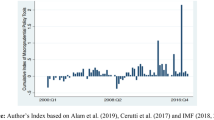Abstract
This paper uses a small and simple theoretical DSGE model in order to conduct some exercises in comparative dynamics of shocks that can be associated with Brexit. We do so by comparing two policy environments, one where a flexible macroprudential regulation (FMR) is in place and one, where this is not the case. This enables us to evaluate whether and to what extent FMR helps to mitigate the Brexit related shocks. We conclude that FMR would indeed be helpful, although in quantitative terms only slightly so.







Similar content being viewed by others
Notes
In the arguably most restrictive database for scientific publications in economics a search for Brexit AND effect (OR some synonyma) returns 172 papers; the same exercise in Google Scholar leads to 37.900 (sic!) hits.
Queen Elizabeth – whose private wealth was also severly affected by the crisis – famously asked why nobody saw the crisis coming during her first visit ever to the London School of Economics in late 2008. It would be interesting to discuss the nature and depth of the professional ignorance. But the profession should be very clear about the impossibility to forecast specific and rare events and their timing. Here it might suffice to note that there have been quite a few voices around who pointed to patterns in the sense of von Hayek (2007) that were destabilizing financial markets. This is also true with respect to the recent de-regulation of financial markets in the U.S. by the Trump administration.
We do not assume an autoregressive process for γt here, because the effects we get would not be qualitatively different, albeit more pronounced.
References
Aliber RZ, Kindleberger CP (2017) Manias, panics, and crashes: a history of financial crises, 7th edn
Bank of England (2018) EU withdrawal scenarios and monetary and financial stability A response to the House of Commons Treasury Committee. (November), 1–88
Borio CEV, Shim I (2008) What can (macro-) prudential policy do to support monetary policy?
Busch B, Matthes J (2016) Brexit-the economic impact: a meta-analysis. Technical report, IW-Report
Dehmej S, Couppey-Soubeyran J (2017, 06) The role of macro-prudential policy in the prevention and correction of imbalances in the euro area. Technical report
Farhi E, Werning I (2016) A theory of macroprudential policies in the presence of nominal rigidities. Econometrica 84(5):1645–1704
Grossman GM, Rossi-Hansberg E (2008) Trading tasks: a simple theory of offshoring. American Economic Review
Guerrieri L, Iacoviello M (2015) OccBin: a toolkit for solving dynamic models with occasionally binding constraints easily. J Monet Econ 70:22–38
Iacoviello M, Neri S (2010) Housing market spillovers: evidence from an estimated DSGE Model. Amer Econ J Macroecon 2:125–164
Jerger J, Körner J (2018) Assessing macroprudential regulation: the role of the zero lower bound. Appl Econ Lett 25(9):580–583
Klingelhöfer J, Sun R (2017) Macroprudential policy, central banks and financial stability: evidence from China
Korinek A, Simsek A (2016) Liquidity trap and excessive leverage. Amer Econ Rev 106(3):699–738
Lambertini L, Mendicino C, Punzi MT (2013) Leaning against boom-bust cycles in credit and housing prices. J Econ Dyn Control 37(8):1500–1522
Minsky HP (1977) The financial instability hypothesis: an interpretation of Keynes and an alternative to “standard” theory. Challenge
Patel O, Reh C (2016) Brexit: the consequences for the EU’s political system. UCL Constitution Unit Briefing Paper 1–5
Rubio M, Carrasco-Gallego JA (2015) Macroprudential and monetary policy rules: a welfare analysis. Manch Sch 83(2):127–152
Rubio M, Yao F (2017) Macroprudential policies in a low interest-rate environment. Working Paper (April 2017)
Schoof U, Petersen T, Aichele R, Felbermayr G (2015) Brexit ? potential economic consequences if the UK exits the EU. Bertelsmann Stiftung
von Hayek FA (2007) Die Theorie komplexer Phänomene. In: Gesammelte Schriften, A 1, Wirtschaftstheorie und Wissen
Wadsworth J, Dhingra S, Ottaviano G, Van Reenen J (2016) Brexit and the impact of immigration on the UK. CEP Brexit Anal 5:34–53
Acknowledgments
We are grateful for comments of participants of the workshop “The Influence of Brexit on the EU28: Banking and Capital Market Adjustments plus Macro Perspectives” on October 12, 2018 in Frankfurt/Main.
Author information
Authors and Affiliations
Corresponding author
Additional information
Publisher’s note
Springer Nature remains neutral with regard to jurisdictional claims in published maps and institutional affiliations.
Rights and permissions
About this article
Cite this article
Jerger, J., Körner, J. Brexit and macroprudential regulation: a DSGE perspective. Int Econ Econ Policy 16, 51–64 (2019). https://doi.org/10.1007/s10368-018-00429-8
Published:
Issue Date:
DOI: https://doi.org/10.1007/s10368-018-00429-8




